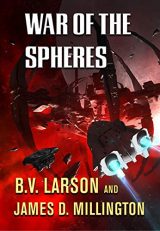SF Reviews: The Grand Alliance and War of the Spheres
Sunday , 10, February 2019 Book Review Leave a comment Jay Allan’s Blood on the Stars series, of which The Grand Alliance is the eleventh book, is the heir to David Weber’s epic Honor Harrington series.
Jay Allan’s Blood on the Stars series, of which The Grand Alliance is the eleventh book, is the heir to David Weber’s epic Honor Harrington series.
High praise, to be sure, and a statement that sets high expectations for readers. This feat is even more impressive as Allan is not writing Hornblower in Space, yet still conveys the heart of the naval tale: wooden ships and iron men. Denied the escalating technological arms race of Honor Harrington, Allan’s Tyler Barron must rely on leadership, motivation, diplomacy, and his damage control crews to outfight the numerically superior Union and the technologically superior Hegemony. In earlier books, Allan conveys the tension of a damage control race between opposing ships vying to bring their guns back online first without resorting to Star Trek physics-defying wizardry or Honor Harrington’s occasional forays into the accountant’s view of war.
In The Grand Alliance, now-Admiral Barron is gathering forces to retake the Confederation’s capital after the brutal battle that stopped the Hegemony’s invasion. He needs time to rebuild his fleet, time that will only make the Hegemony invaders increasingly stronger than his forces can ever become. While the rump of the Confederation’s government seeks to negotiate with the invaders assimilating their citizens, Barron decides to risk it all in one last drive to the Capital. But first he must draw away enough Hegemony ships to give his strike a chance.
The resulting campaign, from first raid to the final and decisive throw of the dice, forces the fleet to endure hardship, attrition, and even setback. Allan humanizes these costs without grinding the reader down or diving into anti-war cliche. It is right, good, and necessary to fight for one’s homeland, but scars are unavoidable. This human focus means that when it comes time to determine if Barron’s gamble leads to victory or disaster, the action is riveting as Confederation fighters lash out at Hegemony escorts and the lines of battleships duel, uninterrupted by clinical descriptions of ordnance and volume. The result reads like a “good parts” abridgment of a Honor Harrington novel while still maintaining its own identity.
 War of the Spheres, by B. V. Larson and James D. Millington, begins as a security operative staggers out of suspended animation. Plagued with gaps in his memory, Chief Gray is assigned to protect a military research and development program plagued by strange disappearances. But when Chief Gray finds the lead scientist gutted by a shadowy alien assassin, he learns the truth about the program. It is an attempt to create a new propulsion system to breach the force sphere around the solar system that imprisons humanity. Now Chef Gray must fight against alien spies, an entrenched military bureaucracy, the vices of supervisors and scientists, and even his own replacement to make sure this moonshot project succeeds.
War of the Spheres, by B. V. Larson and James D. Millington, begins as a security operative staggers out of suspended animation. Plagued with gaps in his memory, Chief Gray is assigned to protect a military research and development program plagued by strange disappearances. But when Chief Gray finds the lead scientist gutted by a shadowy alien assassin, he learns the truth about the program. It is an attempt to create a new propulsion system to breach the force sphere around the solar system that imprisons humanity. Now Chef Gray must fight against alien spies, an entrenched military bureaucracy, the vices of supervisors and scientists, and even his own replacement to make sure this moonshot project succeeds.
Larson has sold over three million books by sticking to a simple formula. A military-minded man gets swept up into secretive events driven by contact with a previously unknown group of aliens, and only succeeds in finding the best course of action for Earth because he is unencumbered by the vices of lesser men–including many of the vices celebrated by more traditional science fiction writers. Larson’s heroes especially are plagued by arrogant and uncooperative scientists who are worthless in social settings, but must be endured for their occasional utility. The technology and nature of the threat change from series to series, keeping the formula fresh.
Here, the conflict is spy versus spy as Chief Gray tries to keep the new star drive out of the hands/claws/manipulators of an insectoid alien crew trying to steal it through commando raids. Compared to the galaxy-spanning conflicts in earlier Larson series, the smaller scope keeps Chief Gray’s involvement small–nowhere near the imperial heights that previous protagonists climbed. Gray’s other strength is his social skills. He might not be deferential, or polite, or even agreeable, but his approach is direct and convincing:
“You left Logan out there,” Whitman said bluntly.
“That’s better than having that thing in here with us, isn’t it?”
“You shoved him out.”
I looked Whitman in the eye. “Yes, I did.”
He thought about that, and he nodded his head. “You played it right. Logan was always impossible. He knew it all–you couldn’t tell him anything.”
For once, we get science fiction that refuses to glorify the secret king, choosing instead to stuff him in a locker at every chance. This isn’t out of cruelty, since the vices of lesser men, cowardice, gluttony, pride, jealousy, etc., actively threaten Chief Gray’s mission and get a space station of bystanders killed. But while countless warnings of what not to be abound in the Chief’s path, no aspirational examples exist. Chief Gray is the sole man of virtu in the world of vice, and I hope sequels will show how fellow men like the Chief interact and support each other’s missions. In the meantime, following the Chief as he stalks alien commandos across the solar system is an unabashed pleasure.
Please give us your valuable comment